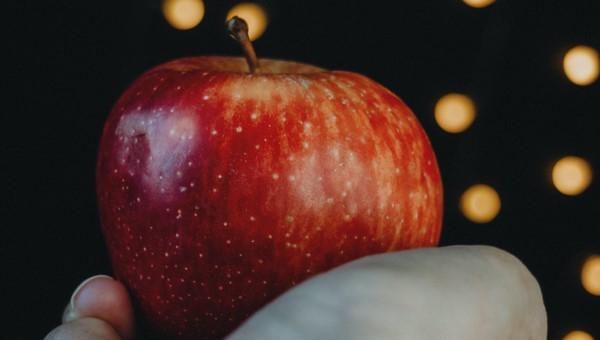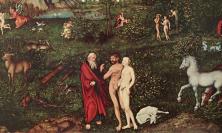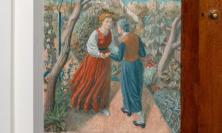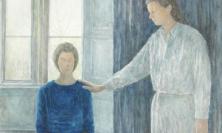Does it surprise you to know that there was a feast of Saint Adam and Saint Eve that was celebrated on 24 December? Karen Eliasen wonders if we could rediscover something valuable, even consoling, in the way we think about Eve by pondering her connection with Mary as she is about to enter motherhood.
The kind of home that I grew up in was not in any sense ‘religious’ – there was no church-going, no salvation stories, no God-talk. Except at Christmas! At Christmas there was still no church-going, but Handel’s Messiah got listened to, trumpet-blowing angels and shining stars got hung up all around the house, and religion got talked about. Not at length, not in depth, but convictions to do with religion were aired by both my parents. Each had a favourite Christmas party-line: ‘All religions foster violence!’ (my father); and, from my mother, ‘virgin birth? Jesus would have been a girl!’ I remember hearing these convictions over three decades worth of Christmases, convictions voiced loudly but never elaborated upon.
My own appropriation of religion falls immensely far from my parents’ unexamined dismissal of it; but those twin themes of violence and gender are not at all foreign to what continues to get my attention about religion, and what religion’s texts address. Chances are that anyone who like me has a penchant for the Old Testament does not shy away from attending to the sex and violence pervading those ancient texts. References to violence have been regularly flaring up in our Advent readings, but what I want to highlight here as we approach Christmas Eve is the gender theme. No, not the girl-Jesus insinuation, but rather what I have come to think of as the women-at-the-nativity-scene issue: plenty of men there – but where are the women, apart from Mary? With a little help from Ignatian imaginative contemplation, I want to consider how the very first woman, Eve, might be making her presence known at the nativity scene; so the Eve of the title of this piece covers a woman as well as a date – the nod being to that memorable 1950 Bette Davis film, All About Eve.[1] What follows briefly touches upon some variations on that gender theme, variations that I find at play in my imaginative contemplations this Advent season. The question that prods these contemplations runs along the lines of: ‘Just what do Eve and Mary really have to do with one another? What is their relationship about – and what is happening in that relationship at Christmastide? And above all, how are women to be consoled rather than dispirited by this relationship?’
‘Consoled’ is the word I use here on purpose, in what may seem a subversive move away from the ‘Eve-brings-death-(and-nothing-but)-and-Mary-brings-life-(and-nothing-but)’ tradition – an overfamiliar but still powerful trope in which a sinful and sexy Eve is thoroughly replaced by a pure and demure Mary. It is a trope that makes a direct appearance every year in the liturgical calendar, perhaps not coincidentally in Advent. On 8 December, the readings for the solemnity of the Immaculate Conception remind us that Eve and Mary are different: one ‘gave me the fruit’ and the other in contrast ‘won God’s favour’ – and who of us does not know precisely what the inferences here are. But those readings equally remind us that Eve and Mary have something in common: a role at the beginning of a life. Eve is named ‘the mother of all those who live’ and Mary is told that she is ‘to conceive and bear a son.’ We tend to forget that included in ‘all those who live’ is Mary herself, and I do not feel content with a take on these readings that ousts Eve from an honoured place in the equation defining Mary as a daughter of Eve. Cardinal Newman liked to qualify this equation by describing Mary as the daughter of Eve unfallen (the rest of us are daughters of Eve fallen), but that only makes me wonder what offspring Eve had in her unfallen state, because Genesis certainly does not mention any; Cain, Abel and Seth were all born to Eve fallen.[2] Avoiding the unhelpful either/or sharpness of the unfallen/fallen division, I wonder what of Eve’s basic goodness survives intact through all the generations down to Mary. It turns out that the Church itself has in the past considered not so much the goodness of Eve as her outright saintliness. If we look at how people in the Middle Ages celebrated Christmas, we get a taste of this unusual idea of a Saint Eve – the one I imagine being there with Mary on Christmas Eve.
Back in the Middle Ages, the Church’s liturgical year included (at least in central and northern Europe) a celebration of the feast day of Saint Adam and Saint Eve on 24 December. The day would include the performance of a kind of mystery play called a paradise play, complete with a tree prop decorated with apples and sometimes communion wafers. The play would work its way through (I imagine with great gusto) the whole Garden of Eden narrative, with the added ending of the promise of the coming of a saviour.[3] Obviously the feast was meant to be a proper preparation for Christmas Day itself by encouraging a comparison of Adam and Eve with Jesus and Mary along disobedience/obedience lines. But the fact that Eve could be considered in the saintly category at all suggests a hint of a recognition of the complexity of Eve that I, close to a millennium later, find refreshing and inspiring. According to the Catechism of the Catholic Church: ‘The patriarchs, prophets and certain other Old Testament figures have been and always will be honoured as saints in all the Church’s liturgical traditions,’[4] but Eve as such a one has rarely been on the cards in the Church’s acknowledgement of these saints. Yet here she turns up, against all odds, as a saint on Christmas Eve!
I have seen the odd icon of Hagia Eva as part of the traditions of Eastern Christianity, but it is in modern iconography that she comes into her own – I am thinking here of a most extraordinary icon of Eve by the contemporary American Franciscan, Robert Lentz. His icon of Hagia Eva speaks volumes about celebrating not the black-and-white difference between Eve and Mary but celebrating instead what links these two women in their mother-daughter relationship.
The icon has been published in a book by Joan Chittister called A Passion for Life: Fragments of the Face of God. Icons of Robert Lentz.[5] Chittister begins her essay accompanying the icon with this bleak truth: ‘It is hard to imagine anyone who has been scorned more often or rejected more universally than the woman Eve.’ So it is perhaps not surprising that when I first came across the icon a couple of years ago, I found myself nodding along with one of the Ten Commandments: ‘Honour your father and your mother, as Yahweh your God has commanded you, so that you may have a long life and may prosper in the country which Yahweh your God is giving you.’ (Deut 5:36) The Church has a long and embarrassing history of teaching us not to bother about this commandment when it comes to Eve, the mother of us all. What, I wonder, would it be like to stop the scorning, stop the rejecting, and take this commandment to heart?
In appreciating Lentz’s Hagia Eva and its presentation of Eve not as young, naked and seductive, but as old, fully- and plainly-robed and crone-like, I imagine Mary honouring this great ancestress of hers. And I imagine Mary being consoled by everything good about being a woman that comes down to her through aeons of daughters of Eve. I have to admit that I am in no small way inspired to give such imaginings free rein by modern science and its playful use of the term ‘Mitochondrial Eve’. The term refers to the scientific impression that the mitochondrial DNA in modern humans is inherited from a single common ancestress who lived in Africa some 200,000 or so years ago – modern genetics traces us all back to this one woman. The catch is that although all women and men have these mitochondria in their cells, only women pass them on (to both daughters and sons).[6] And these mitochondria are essential to pass on as they generate most of the chemical energy needed to power our cells’ biochemical reactions. This is a physical, concrete thread (the Greek mitos means thread) that links Mary through other women right back to Eve, but is there also an abstract, conceptual thread? A small prayer-poem written by Kathleen Schatzberg in response to Lentz’s Eve icon has the suggestive title Crone of Hope and Strength and contains these affirmations of Eve’s gifts to us:[7]
Your wisdom speaks to us through the centuries,
Your care for all creation challenges us,
Your curiosity empowers us,
Your boldness inspires us.
Concrete or conceptual, there is something about Lentz’s icon that insists we consider what Eve has to offer that is worth accepting. Not sex and temptation, but wisdom and curiosity; not self-obsession and cowardice, but care for all creation and boldness. How subversive can a take on Eve get! How subversive can a take on the relationship between Eve and Mary get! Actually, I think the subversiveness goes even deeper.
Of Woman Born: Motherhood as Experience and Institution is a landmark book by the American poet Adrienne Rich first published in 1976. At its heart is a chapter titled ‘Motherhood and Daughterhood’ in which Rich describes something beyond both mitochondria and virtues that mothers and daughters share: ‘Mothers and daughters have always exchanged with each other – beyond the verbally transmitted lore of female survival – a knowledge that is subliminal, subversive, preverbal: the knowledge flowing between two alike bodies, one of which has spent nine months inside the other.’ With such a conviction in mind, I imagine that on Christmas Eve as labour kicks in, a knowing calm descends on Mary with the presence of this ancient wise-woman archetype. I imagine that the Mary giving birth engages with Eve not as a toxic foremother who ruined everything for the rest of us, but as the great ur-foremother whose experience and wisdom Mary relies on as she gives birth. We are so used to neat and bloodless nativity scenes that we may find it well-nigh impossible to imagine Mary in any kind of realistically embodied context – but consider the following description of a birth that captures any birth’s nexus of the real and the ancient. It is a description of being there by J. Philip Newell in his Christ of the Celts: The Healing of Creation:
I shall always remember the primal scream of my wife, Ali, at the birth of Rowan, our first child. It was a sound I had never heard before, but it was deeply familiar because it was coming from a place close to the heart of life. It came forth not just from Ali’s physical and spiritual depths. It came from the beginning of time. It was deep and prolonged like the history of the universe. In it, I was hearing the birth of every creature and the great ruptures of earth’s labour.
What a far cry from the mansplaining of much Marian theology this deeply experienced response to a woman giving birth is – just as Lentz’s Hagia Eva crone is a far cry from the nubile blondes we are used to looking at when we look at traditional paintings of Eve. With such a text and such a picture for prayer company (both, ironically yet thankfully, by men), how can anyone doubt that there is something ancient and life-giving and consoling going on between Eve and Mary on Christmas Eve?
Karen Eliasen works in spirituality at St Beuno’s Jesuit Spirituality Centre, North Wales.
[1] If you are looking to do an Eve-related old-film-classics marathon this Christmas, then give this sequence a go: Adam’s Rib with Katharine Hepburn (1949), All About Eve with Bette Davis (1950) and The Three Faces of Eve with Joanne Woodward (1957) – all excellent and entertaining, but all also worthy of some serious gender pondering.
[2] Scripture mentions only these three sons as Eve’s children, although Genesis 5:4 mentions that after the birth of Seth, Adam ‘fathered sons and daughters.’ Some apocryphal writing, including the Gospel of Eve, does mention a fourth child of Eve, a daughter called Norea. Gnosticism makes much of this daughter as a fallen wisdom-type figure. Grist for another imaginative contemplation.
[3] The end of the Middle Ages also spelled the end of mystery plays (officially banned by the Church in the 15th century). It is tempting to relate these early decorated trees to our modern Christmas trees.
[4] Catechism of the Catholic Church, §61,
[5] Visitors to St Beuno’s may be more familiar with another book of Robert Lentz’s icons, Christ in the Margins, which remains on display there in the Chapel Corridor.
[6] I am aware of how playing metaphorically with a scientific description is not the same as literalizing it. On this note see Joshua Rapp’s article ‘No, a Mitochondrial “Eve” Is Not the First Female in a Species’ at https://www.smithsonianmag.com/science-nature/no-mitochondrial-eve-not-first-female-species-180959593/ : ‘While everyone below is descended from her [Mitochondrial Eve], that doesn’t mean that there is no other female above her, or that lived at the same time as her. Perhaps some of her contemporaries had no surviving children. Or they only had sons, which wouldn’t have passed on their mitochondrial DNA.’
[7] See the full prayer at http://www.monasteriesoftheheart.org/eve-crone-hope-and-strength






